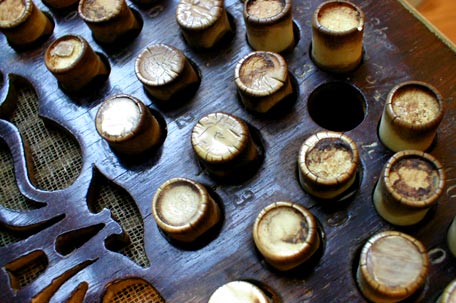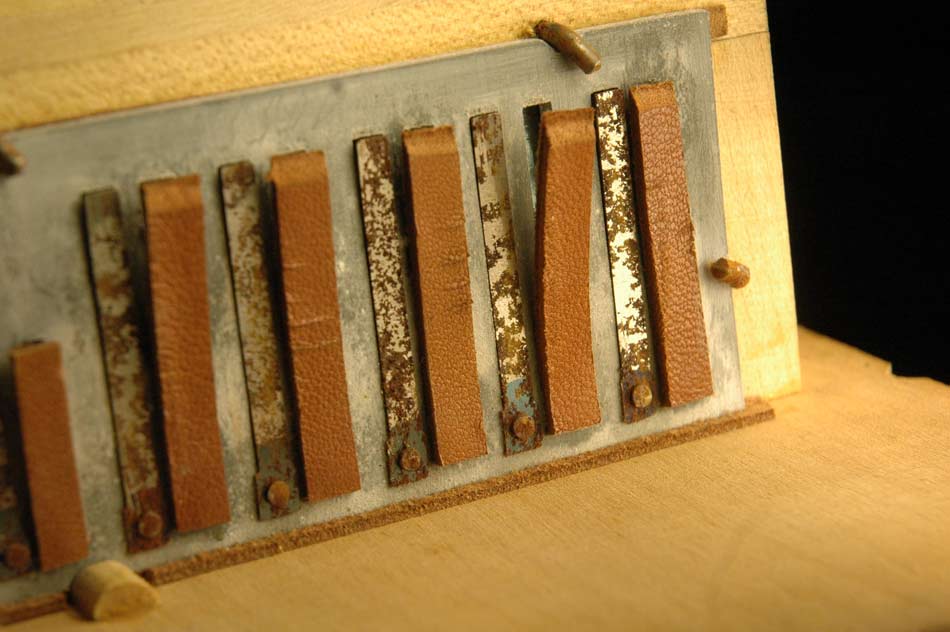

| Carsten Heveling |
| Bando-Aspekte Bandoneon aspects aspectos aspects aspetti |
... zurück back volver retour indietro |
| Preis (Bewertung) Möglichkeiten zur Findung des Zeitwertes eines Bandoneons |
Value evaluations possibilities for finding the time value of a classic Bandoneon |
||||||||||||||||||||||||||||||||||||||||||||||||||||||||||||||||||||||||||||||||||||||||||||||||||||||||||||||||||||||||||||||||||||||||||||||||||||||||||||||||||||||||||||||||||||||||||||||||||||||||||||||||||||||||||||||||||||||||||||||||||||||||||||||||||||||||||||||||||||||||||||||||||||||||||||||||||||||||||||||||||||||||||||||||||||||||||||||||||||||||||||||||||||||||||||||||
| Die Bewertung eines Musikinstrumentes ist nicht einfach. Es ist ein emotionaler Gegenstand. Ein Bandoneon ist dazu mechanisch komplex und mit seiner Spielbarkeit vom Zustand vieler Teile sowie mit der Oktavstimmung von einer Einstellung mit extrem hoher Präzision abhängig. Um den Wert eines Bandoneons zu errechnen hat man verschiedene Faktoren zur Verfügung: 1. Subjektive Einschätzung des Klangs, der Kraft, der äußeren Schönheit, Spielbarkeit ... 2. Objektive Einschätzung des Zustandes (Stimmzungen, Stimmplatten, Zungennieten, Mechaniken, Luftklappe, Balg, Gehäuse) Bei der objektiven Bewertung können die verschiedenen Faktoren unterschiedlich gewichtet werden. Mit Ausnahme der Stimmzungen, Nieten und Platten kann alles an einem Bandoneon, egal in welchem Zustand, gut restauriert werden. Ein Balg kann ersetzt, Mechaniken wieder aufgebaut und selbst ein zerstörtes Gehäuse mit sehr gutem Ergebnis wiederhergestellt werden. Daher ist bei der objektiven Bewertung der Zustand der Stimmzungen, Nieten und Platten sehr hoch zu bewerten. Die Tonerzeugung von Zunge und Platte läuft praktisch verschleißfrei. So führt intensives oder gar aggressives Spiel über Jahrzehnte zu keinerlei Abnutzung oder Substanzverlust an den Zungen in irgendeiner Form. Substanzverlust kann hier nicht vom Alter oder der Benutzung herrühren, sondern nur von Stimmprozessen. So wird bei jedem Stimmprozeß Substanz von der Zunge entfernt, nicht hinzugefügt. Fachmännisch ausgeführt, ist der Materialabtrag so gering, daß dieser für die Lebensdauer einer Stimmzunge praktisch nicht ins Gewicht fällt. Fachmännisch gestimmt, lebt ein Bandoneon ewig. Gespielt, gepflegt und fachmännisch gestimmt ist ein Bandoneon praktisch nicht dem ewigen Kreislauf der Natur von werden, wachsen, blühen, welken und vergehen unterworfen. ... siehe Video "Loca" (Juan D´Arienzo, 1972) Unfachmännisch bearbeitete Stimmzungen, Stimmplatten und Nieten zeigen Beschädigungen der Struktur und Deformationen. Solche substanziellen Schäden sind nur eingeschränkt restaurierbar und bedeuten oft den dauerhaften Verlust von natürlicher Klangschönheit, Ausgewogenheit, Kraft und guter Ansprache. Wertfindung Um den Zeitwert eines klassischen Bandoneons zu ermitteln, kann man unterschiedlich vorgehen. 1. Preisvorstellung des Besitzers aufgrund des Anschaffungspreises, gemachter Investitionen, einer Marktsondierung und der Wertvorstellung gesehen mit dem Herzen. 2. Festlegung eines Maximalpreises für einen imaginär möglichen Bestzustand nach Vollrestaurierung abzüglich der Aufwendungen. Also Wert in Bestzustand minus Aufwand nach Kostenberechnung gleich Istwert. 3. Um eine weitere, objektivere, Möglichkeit der Berechnung zu bekommen, habe ich ein Schema entwickelt. Dabei vergebe ich Punkte zwischen 1 und 10 für den Istzustand der verschiedenen Bauteile eines Bandoneons. Die Codenummern der Bauteile korrespondieren dabei mit dem Schema zur Erstellung von meinen detaillierten Kostenvoranschlägen. Die von mir vergebenen Punkte für jeden Teilaspekt werden mit einem bestimmten Faktor multipliziert. Dieser Faktor soll das zu erwartende Restaurierungsergebnis im Verhältnis zum Aufwand abbilden. So sind zum Beispiel die Balgrahmendichtungen (code E02, siehe "Restaurierung") mit dem Faktor 0,2 problemlos mit sehr gutem Ergebnis restaurierbar. Dagegen ist der Zustand von Stimmzungen und Nieten mit dem Faktor 10 als höchster Wert eingetragen (siehe Erklärung zu Platten und Zungen oben). Die so ermittelte Gesamtpunktezahl bildet das objektive Abbild eines Istzustandes ab und kann in das Verhältnis zu einem Verkaufspreis gesetzt werden. Dieses System soll den technisch-objektiven Vergleich von Bandoneons im jeglichen Zustand erlauben.
Legende Code: Von mir vergebene Einteilung der Baugruppen eines Bandoneons zur Erstellung von detaillierten Kostenvoranschlägen. ... siehe auch "Restaurierung" Teilbereich: Bezeichnungen einzelner Bauteile. Faktor: Mit dem Faktor werden die vergebenen Punkte der Teilbereiche multipliziert. Er soll das zu erwartende Restaurierungsergebnis im Verhältnis zum Aufwand abbilden. Zustand: Vergabe von Punkten des Istzustandes eines jeden Teilbereiches zwischen 1 und 10. Die Totale Punktezahl kann ins Verhältnis zu 804 möglichen Punkten gesetzt werden welche wiederum in ein Verhältnis zu einem Verkaufspreis gesetzt werden kann. |
 Unrestaurierte Knöpfe eines AA-Bandoneons der fühen 1930er-Jahre ... siehe auch Artikel "Knöpfe" Unrestored buttons of an AA-Bandoneon from the early 1930ies ... see also article "buttons" The evaluation of a musical instrument is not easy. It's an emotional item. A Bandoneon is mechanically complex and its playability depends on the condition of many parts as well as the octave tuning of a setting with extremely high precision. Various factors are available to calculate the value of a Bandoneon: 1. Subjective assessment of sound, power, outer beauty, playability ... 2. Objective assessment of the condition (reeds, reed plates, rivets, mechanics, air valve, bellow, housing). In the objective assessment, the various factors can be weighted differently. With the exception of the reeds, rivets and plates, everything on a Bandoneon, regardless of the condition, can be restored well. A bellow can be replaced, mechanics can be rebuilt and even a damaged housing can be restored with very good result. Therefore the condition of the reeds, rivets and plates is decisive for the objective evaluation. The sound generated by the reed and plate is practically wear-free. For decades, intensive or even aggressive play does not lead to any wear and tear or loss of substance on the reeds in any form. Loss of substance here cannot result from age or use, but only from tuning processes by tuners. So with every tuning process, substance is removed from the reed, not added. Expertly executed, the material removal is so small that it is practically negligible for the life of a reed. Expertly tuned, our Bandoneons lives forever. Played, cared for and expertly tuned, a Bandoneon is not subject to the eternal cycle of nature of becoming, growing, blooming, withering and perishing. ... see Video "Loca" (Juan D´Arienzo, 1972) Incorrectly processed reeds, reed plates and rivets show damage to the structure and deformations. Such substantial damage can only be restored to a limited extent and often means the permanent loss of natural sound beauty, balance, power and good response. Determination of value To determine the current value of a classic Bandoneon, one can proceed differently. 1. The owner's asking price based on the purchase price, investments made, a market sounding and the value concept viewed with the heart. 2. Determination of a maximum price for an imaginary possible best condition after full restoration minus the expenses. So value in best condition minus effort after cost calculation equals actual value. 3. To get a further, more objective, possibility of calculation, I have developed a scheme. I award points between 1 and 10 for the actual condition of the various components of a Bandoneon. The code numbers of the components correspond to the scheme for creating my detailed restoration cost estimates. The points I have given for each aspect are multiplied by a certain factor. This factor should show the expected restoration result in relation to the effort. The bellow frame gasket for example (code E02, ... see "Restoration") can easily be restored with a factor of 0.2 with very good result. In contrast, the condition of reeds and rivets is entered with a factor of 10 as the highest value (see explanation on plates and reeds above). The total number of points determined in this way represents the objective image of an actual situation and can be set in relation to a sales price. This system is designed to enable a technical and objective comparison of Bandoneons in any condition.
Legend Code: I have assigned the assembly groups of a Bandoneon for the preparation of detailed restoration cost estimates. ... see also "Restoration" Aspect: Designations of individual components. Factor: The points awarded for the different aspects are multiplied by the factor. It should show the expected restoration result in relation to the effort. Status: Allocation of points of the actual state of each aspect between 1 and 10. The total number of points can be set in relation to 804 possible points, which in turn can be set in relation to a sales price. |
||||||||||||||||||||||||||||||||||||||||||||||||||||||||||||||||||||||||||||||||||||||||||||||||||||||||||||||||||||||||||||||||||||||||||||||||||||||||||||||||||||||||||||||||||||||||||||||||||||||||||||||||||||||||||||||||||||||||||||||||||||||||||||||||||||||||||||||||||||||||||||||||||||||||||||||||||||||||||||||||||||||||||||||||||||||||||||||||||||||||||||||||||||||||||||||||
 Oxidation an den sonst guten Stimmzungen eines AA / Peguri (gleichtönig) aus den 1930er Jahren. Ein solch extremer Fall ist zum Glück selten. Oxydation on the otherwise well preserved reeds of an AA / Peguri (unisonor) from the 1930s. Fortunately, such extreme case is rare. |
| © 1998-adhuc BANDO BANDO Wuppertal | |
| Kontakt / Impressum Datenschutzhinweis & Hinweise zur Nutzung |